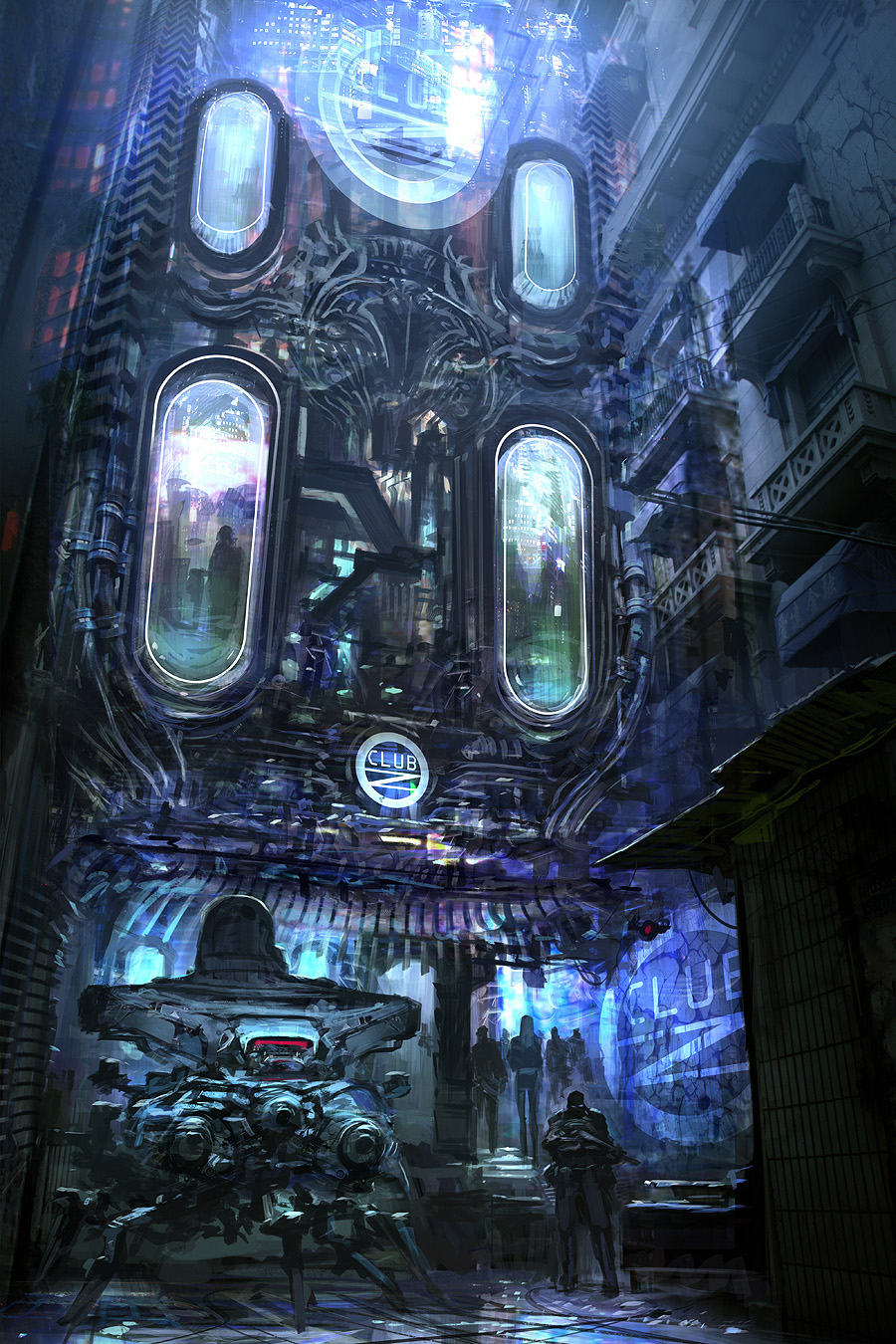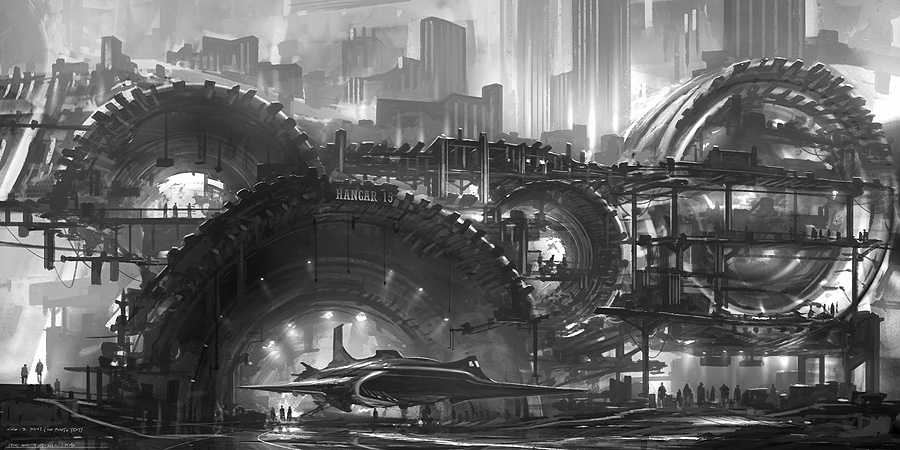 For more than 14 years, Feng Zhu has contributed to some of the highest profiled projects in the entertainment industry. His broad design skills allowed him to reach across into many fields from hit movies, to triple-A games, memorable TV commercials and toy designs.
For more than 14 years, Feng Zhu has contributed to some of the highest profiled projects in the entertainment industry. His broad design skills allowed him to reach across into many fields from hit movies, to triple-A games, memorable TV commercials and toy designs.
Founding his own design company, Feng Zhu Design (FZD), his clients included Microsoft, Electronic Arts, Sony, Activision, Industrial Light+Magic, NCSoft, Warner Brothers, Lucasfilm, Bay Films, Epic Games, and many other top studios. In Hollywood, he has worked closely with well established directors including George Lucas, Steven Spielberg, James Cameron, Michael Bay and Luc Besson.
How could You describe your beginnings as a designer?
I must admit that I didn't think about being a designer when I was younger. I was just drawing for fun, that's it. But I was interested in how things work. I took a couple of toys apart when I was a kid. I wanted to know how they were made – how do the wheels turn, how does the motor work. It helped me a lot, because good design is understanding, not just drawing. Drawing is really very secondary to what I do.
Click on image to enlarge
Concept art by Feng Zhu
Click on image to enlarge
Concept art by Feng Zhu
What is your biggest source of inspiration?
I think that there are two main inspiration sources for me – nature and machinery. When I was not dissasembling toys, I watched birds, bugs and insects in my backyard and read a lot of books about farm vehicles, tanks or construction vehicles.
I am also inspired by the works of the great directors, like Steven Spielberg, James Cameron or George Lucas – they brought inspiring visions to reality. There is a lot of the great design in their works. I would like to ask them: „How did You make Indiana Jones?”, „How did You make Star Wars”?
Click on image to enlarge
Concept art by Feng Zhu
What was the project that you liked the most? Most interesting or challenging project that you have worked on?
I think that was Star Wars. You know – being a part of this movie franchise is a big deal. And working with George (Lucas – ed.) was really great fun. I was put in a very strong art department – ILM LucasFilm Art Department. I was surrounded by very experienced designers. Our work environment was awesome – we were at Skywalker Ranch – a private ranch in the middle of nowhere. I worked there every day for a year and a half with six other concept artists. It was very creative time, cause we didn't have to follow some strict design rules.
I must admit that it was also time consuming – if you work in a team of skilled artists, there is a strong competition. Some days I worked for a long time to make as many concept drawings as possible, because I didn't want to lag behind the rest of the team. You can imagine that we did thousands of drawings during that period.
Click on image to enlarge
Concept art by Feng Zhu
Do You remember your first commercial project?
It was a movie called „Soldier” with Kurt Russel. I was still in school at that time. My teacher was a production designer of this movie and I was helping out. My first paid project I made for Origin systems which is now part of EA. They were really big back in 1998. it was one of biggest game companies, they were as big as Blizzard at the time. I was working on a project „Wing Commander online” which was cancelled, but I worked there for about a year.
Click on image to enlarge
Concept art by Feng Zhu
Is there some project that you would like to work on?
There is no a particular project. I like working on projects that are fun to me. It does not matter if it is triple „A” game or some indie game. It has to be fun for designer.
What advice could you give for people that would like to become succesfull in CG?
There are two paths. If you want to put yourself into freelance world, you need some very very big titles on your resume, otherwise you will be uknown. So I recommend to look for work at Microsoft, Ubisoft or Activision and after getting some experience, you can go on your own. But if you would like to work in some studio and don't think about freelancing, you need to find the one that you think that has a potential – it does not have to be big. Every big studio was a small one at the beginning.
Click on image to enlarge
Concept art by Feng Zhu
In both cases you have to work very hard. This business is very deceiving from an amateur perspective. From outside it looks like we just make nice drawings. You know: - Oh, I'll just pick a pencil and a sheet of paper and I can work on next Assassin's Creed” - that's what often amateurs think. But in fact the drawing part has very little to do with design. It is maybe 5 percent of our work. The rest of it is a job that requires a designer's mind. If you want to reach the high level as a concept designer you have to work really hard, just like any professional – doctor, rocket scientist, etc. I think that a lot of younger designers don't realize how hard it is to actually go this path.
Click on image to enlarge
Concept art by Feng Zhu
Click on image to enlarge
Concept art by Feng Zhu
Do beginners need design schools or maybe they can learn everything by themselves?
If you asked me the same question 10 years ago I would say that you probably don't need to go to any school. Because at the time there were maybe nine concept artists available. You could probably find a very good job if you had a great imagination – even drawing skill was not that important. There weren't enough concept artists around.
Nowadays if you would like to learn on your own, you could still do it, but you would have a hard time, because of the competition trained in design schools. Those facilities not only teach how to draw things but also teach the workflow of the cg industry, some things that a person will not probably figure out on his/her own.
When companies are interviewing candidates, they tend to choose those who were trained in professional school. Chances on competing with those artists are weak for a self-taught person.
Click on image to enlarge
Concept art by Feng Zhu
Is there any style of design you like the most?
Yes, sci-fi. Especially – sci-fi done in tasteful way, not „over-cg” - i like the design of Matrix or Blade Runner – very deep story, good production design and they don't use special effects to make the film cool.
Click on image to enlarge
Concept art by Feng Zhu
You are not only a design artist, bu also the founder of FZD School of Design which was established in 2009. Tell us how does an average day in FZD school look like?
We are doing reviews at 10 AM every morning. All the students get their works printed out. There is no hiding, it is very easy to spot lazy students and also promising ones. This meeting lasts about two hours or so. After that students make their homework or practice. They work from 10 to 18.30, like in normal job, 5 days a week. Day at FZD looks like during normal work in cg industry, even the design and names of our facilities are taken from cg industry.
Click on image to enlarge
FZD school
The students are loving the school and many of our former students work in game studios. We have some very talented students in FZD. Sometimes I look at my students work and think: „I wasn't capable of doing that kind of stuff when I was in their age”.
We have the great staff at school - for eg. Ben Mauro and Eduardo Pena, who came from Weta Studios (New Zealand). These two have a lot of experience from movie industry (Weta Digital is a company that have done vfx in „Hobbit” among others).
Click on image to enlarge
Concept art by Ben Mauro
Click on image to enlarge
Concept art by Ben Mauro
Click on image to enlarge
Concept art by Long Ouyang
Most of our students comes from abroad - about 75 to 80 percent. People come to FZD from Europe, South-East Asia, China, Korea, Japan and US and many other countries. Not every single of them is a beginner – 20 to 30 percent are students that came from previous cg experience – they are not concept artists, but for eg. 3D modelers, animators. They already know the pipeline, but want to switch jobs.
What does one has to know to be accepted in FZD?
You need to understand how things work. We are not very particular about how well you draw – because it can be taught, that is what the school is for. We need people with a vivid imagination. You cannot make a good design without it. Most applicants draw on high school level.
Click on image to enlarge
Concept art by Feng Zhu
Has movie industry influenced the way you run the school?
Yes! We work like a real studio, we have a pipeline, we manage things more like producers, not just teachers. We want to give students real deal. We know how it looks like to be in the industry is and we can pass this knowledge. A lot of directors wanting to build art department ask as for our students.
Click on image to enlarge
FZD school
What are your plans for the future?
We plan to expand, give more courses, specific devoted to 3d topics. We want to teach people how to use 3d software as a design tool, like for eg. Zbrush which is now pretty dominant when it comes to designing creatures. Probably 95 percent of them are designed in Zbrush. Real sculpting is dying, all stuff is made digitally and we tend to teach people things that are used nowadays in the industry.
Click on image to enlarge
Concept art by Feng Zhu
What kind of music do you listen to?
When I am working i am listening to soundtracks from movies that I would like to work on – like Conan the Barbarian, a lot of different soundtracks. Soundtracks are not distracting, they just give me a mood :)
Thanks a lot for an inteview.
Customer zone
Your special offers
Your orders
Edit account
Add project
Liked projects
View your artist profile



 For more than 14 years, Feng Zhu has contributed to some of the highest profiled projects in the entertainment industry. His broad design skills allowed him to reach across into many fields from hit movies, to triple-A games, memorable TV commercials and toy designs.
For more than 14 years, Feng Zhu has contributed to some of the highest profiled projects in the entertainment industry. His broad design skills allowed him to reach across into many fields from hit movies, to triple-A games, memorable TV commercials and toy designs.



































COMMENTS